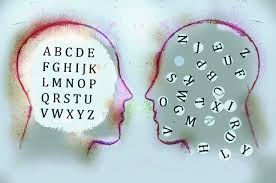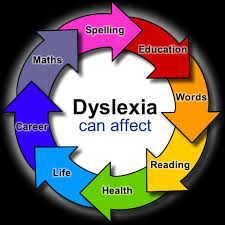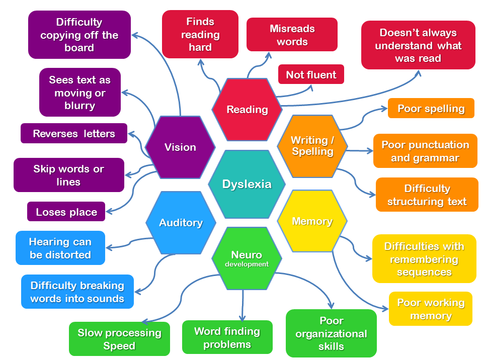6.1.4 Dyslexia
What is dyslexia?

Inability to sequence and process language effectively for reading.
Dyslexia means reading problems or word blindness. It usually refers to reversal of sounds or letters due to poor linear sequential processing or a low sequencing threshold i.e. being unable to detect which of two sounds came first.
This simply means getting the sounds or letters in the wrong order.
Although it appears to be a visual problem, Dr Tomatis says children read with their ears, and he had great success treating dyslexic children in schools.
Tomatis says: “We read with our ears … the ear is the organ of language, the pathway to language assimilation, the key that controls it, the receptor regulating its flow.”
Dyslexia is a language based learning difficulty of neurological origin. It typically includes:
- Difficulty with reading, writing or spelling
- Letter reversals or word reversals
- Visual processing difficulty
- Auditory processing difficulty
- Linear processing difficulty
- Poor short term memory
- Spatial confusion
- Poor organization

Dyslexia typically involves a more complex and convoluted structure in the organization of brain pathways. Dyslexia refers to a cluster of symptoms, which result in people having difficulties with specific language skills, particularly reading, accurate and/or fluent word recognition and poor spelling and decoding abilities.
It is referred to as a learning disability because dyslexia can make it very difficult for a student to succeed academically in the typical learning environment. These difficulties typically result from a deficit in the phonological component of language, which is often unexpected in relation to other cognitive abilities and the provision of effective classroom instruction.
Studies show that individuals with dyslexia process information in a different area of the brain than do non-dyslexics. Many people who are dyslexic are of average, to above average intelligence.
The brain and language

The left hemisphere of the brain is the main centre for processing language. In order for speech sounds to reach the brain efficiently the right ear must take a leading role in listening because the right ear communicates most directly with the left hemisphere.
Dr Tomatis contends that children with dyslexia have failed to achieve right ear dominance and that therefore the order in which they hear sounds becomes jumbled.
If they sometimes use the left and sometimes the right ear as the directing ear, sounds may reach the brain at different speeds, so letters will be jumbled. This accounts for errors of reversal, such as writing “was” as “saw” or pronouncing “spaghetti” as “pisghetti”.
With more up to date diagnostic techniques, many educational specialists now break this condition down more specifically. The new term used is ‘Specific Learning Difficulty’ and this is broken into sub-categories of ‘Visual learning difficulty’ or ‘Auditory learning difficulty’. In fact, because the visual and auditory pathways are so closely linked, most people with dyslexia are bound to have difficulties in both areas. Many also experience co-ordination problems and balance or movement disorders, because of problems in the vestibular system and poor integration of all sensory inputs to the brain.
How does Sound Therapy help with dyslexia?

Wakes up and engages more brain centres into the act of reading by creating right ear dominance and more efficient pathways for language.
By playing a higher volume and higher frequency of sound to the right ear, at the same time as stimulating the brain and opening the ear to the full range of frequencies, Sound therapy encourages right ear dominance.
Right ear dominance is essential for accurate auditory processing because the right ear connects directly to the left hemisphere of the brain, which is the primary language centre.
If the left ear is dominant, sounds take longer to reach the left brain, and the sequence becomes confused. According to Dr. Tomatis, there can be a delay of up to 0.12 of a second in the transfer of information if it goes via the left ear.
The balance between the two hemispheres of the brain is of fundamental importance in overcoming dyslexia.
Both hemispheres play a role in processing language, but the roles they play are different. The eye must combine with the power and quality of the ear to make sense of the written sounds.

This co-ordination happens easily when the left hemisphere deals primarily with audition and the right hemisphere deals primarily with vision. In dyslexia, the route which allows for phonic analysis has been damaged. Sound Therapy may help restore the functioning of this route and eliminate the cause of the problem.
A debate has raged for decades over whether lack of left brain dominance causes dyslexia. The mistake
made by most of these theorists is that they used left-handedness as the measure of right brain dominance. Tomatis, however, looked more deeply into the question, and learned that it is not the dominant hand which is at issue, but the dominant ear. Left-earedness is sometimes, but not always, reflected by left-handedness. In the words of one specialist educator from Los Angeles who has spent decades studying and treating dyslexics, ‘it doesn’t matter if the person is left-eyed, left-handed left-legged, or “left” anything, it will not necessarily cause a problem. But if they are left-eared, they will have a learning difficulty.’
Tomatis believed that the right ear must be the leading ear and that this is the key to proper listening. Another way he expressed the roles of the two sides of the brain is that the right hemisphere is the instrument, and the left hemisphere is the virtuoso, or the one which executes. Right is passive, left is dynamic and active. Tomatis’ findings in this regard were experimentally reproduced. By having people monitor themselves with the left ear, they produced experimental dyslexics.
Children with dyslexia often have feelings of inferiority after repeated failure. It is unfair that they must try many times harder than anyone else to achieve only mediocre results. Sound Therapy may offer immediate emotional relief because it is easy to use and directly addresses the neurological processing problems.
Once the child is able to receive and interpret sound accurately and easily, his or her ability and motivation to communicate is greatly increased. Thus the problem learner is quickly transformed into a receptive and motivated learner.

